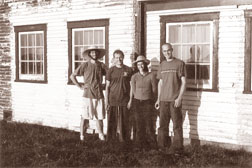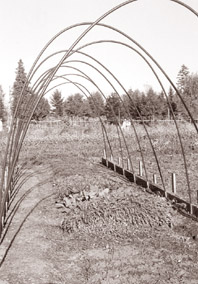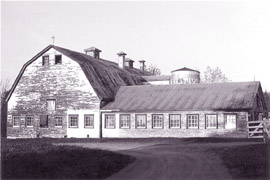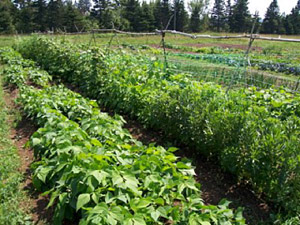 |
| New Brunswick’s historic Bantry Bay Farm is being brought back into production by this intrepid foursome: Mike Hadfield, Luke McLean, Katherine McCord and Brad Aune. Photo by Larry Lack. |
by Larry Lack
A historic saltwater farm in New Brunswick on the St. Croix River near Calais has a new lease on life thanks to the good luck, determination and hard work of four young farmers who migrated east from British Columbia a year ago. The four, who range in age from 21 to 24, worked at various jobs in B.C. but shared a growing interest in food and nutrition. Their dream of learning how to farm brought them to an unexpected rendezvous with an endangered heritage farm where food had not been grown for more than 20 years.
Bantry Bay Farm in Bayside, New Brunswick, which includes over 1,000 feet of cliffs and beach along the rocky, tree-lined estuary of the St. Croix, was the estate of Montreal industrialist Norman Mais and his widow, Margot, who died in 2004 at the age of 87. Mrs. Mais was the granddaughter of Lord Shaughnessy, who was president of the Canadian Pacific Railway from 1899 to 1918.
  |
| The beginning of a hoop house at Bantry Bay. Photo by Larry Lack. |
The expansive farm dates from the 1920s. In its first incarnation this was one of several Bayside farms that supplied Canada and much of the United States with turnips, which at the time were daily fare for many North American families. Fertilized with crushed mussel shells, farms in Bayside, “the turnip capital of Canada,” produced bumper crops until the late1930s, when their bounty of turnips dwindled and then refused to grow at all. The problem, discovered later, was that turnips are susceptible to boron deficiency, and years of monocropping had reduced the boron in Bayside’s soils.
In 1938 a family that summered in St. Andrews purchased the farm and hired a local manager to convert it to a dairy operation. In 1955 Norman and Margot Mais bought the farm and its herd of Jerseys and named it Bantry Bay after her grandfather’s ancestral home in Ireland. Margot, who lived year round at the farm, became its overseer. Milk was trucked to St. Andrews, where it was processed and delivered, along with cream and ice cream, to homes and businesses in the resort town.
The dairy operated until 1980, and for a few more years beef cattle were raised. Later only hay, pulp and firewood were cut, and the farm became mainly a summer gathering place for the Mais family.
  |
| This beautiful, old barn will be preserved on the working farm. Photo by Larry Lack. |
After Margot’s death her family reluctantly considered subdividing the farm, which would have meant demolishing the graceful farm buildings. Those sad thoughts were left behind as a different plan emerged when Katherine McCord, a sister-in-law of Margot’s son Tony Mais, and her partner, Luke McLean, visited the farm in the fall of 2005. Drawn to the open fields and lovely vistas, they asked Katherine’s family about the possibility that they might bring it back into production.
Encouraged, they returned to their home in Coquitlam, B.C., and invited their friends and housemates Brad Aune and Mike Hadfield to join the venture. The four arrived at Bantry Bay in January armed with seed catalogs, reference books – Rodale’s Encyclopedia of Organic Gardening, Ruth Stout’s No Work Garden, Eliot Coleman’s New Organic Farm and Masanobu Fukuoka’s One Straw Revolution (the latter treasured for its author’s insights into low tech farming patterned on the harmonies and plant communities found in nature).
McCord and McLean were introduced to organic agriculture as WWOOFers in B.C. WWOOF (World-Wide Opportunities on Organic Farms, wwoof.org) is an international program that offers volunteers organic farming experience in return for meals and a place to stay. This hands-on introduction, McLean says, “helped us understand the connection between healthy land and healthy food, and got us interested in trying to grow our own food.”
  |
| The proof is in the … beans. Bantry Bay had a banner year, especially for its first year in production in many decades. Photo courtesy of Bantry Bay Farm. |
Despite limited agricultural experience, the four had a remarkably successful first year, producing lots of food for themselves and others. They proved to be competent marketers as well, selling hundreds of pounds of their beautiful produce at the weekly farmers’ market in St. Andrews as well as to area restaurants and inns, and directly from the field to customers who accepted their invitation to visit the farm.
By late July they were selling carrots, beets, turnips, radishes, cabbage, broccoli, peas, zucchini and other summer squash, lettuce and several other salad greens, parsley, cilantro, sage, kale and onions. Later they added tomatoes, cucumbers, cauliflower and beans, and still later, brussels sprouts, corn and winter squash.
As harvesting wound down in October, the energetic foursome was working on a portable greenhouse and remodeling part of their cellar to keep it cool enough for winter storage of root crops. They were also drawing up a list of winter produce customers, planning rotations and their 2007 crops, and expanding the whole-grain bakery business that Brad began this summer, using certified organic grains from Speerville Mill in western New Brunswick.
Bantry Bay produce is not yet certified organic. The co-managers are debating whether they need certification and are leaning toward avoiding the expense and paperwork. Most customers know (or are getting to know) them personally. Many have visited the farm, and no one questions their scrupulous commitment to the ideals of organics. In addition to avoiding inputs that are prohibited in organic agriculture, the growers are feeding, protecting and improving their soil with compost, some of which they are already producing themselves, and with cover crops and green manures.
Conscientious vegans who strive to apply their environmental and nutritional values in their personal lives, the Bantry Bay crew set out to work their half-acre with as little reliance as possible on power equipment. Early in the spring they rented a power sod cutter for a weekend and they used a borrowed rototiller several times during the summer. But most field work was done with hand tools – shovels, hoes and a stand-on broadfork (or U-bar) digger. A truckload of aged horse manure was spread, dug in mostly with hand tools, and supplemented with sheet compost using plant and weed cuttings and kitchen scraps. Pest problems, including a serious infestation of Colorado potato beetles, were dealt with by patrolling and hand picking.
Blessed with excellent growing weather in their first farming year, the new stewards are aware that their early success may be due in part to mining stored fertility of former pasture that included lush stands of clover and some alfalfa.
They’re also acutely aware that McCord’s family, which offered the new arrivals a place to stay in a former family home on the farm, and access to Bantry Bay’s prime cropland, gave them a jump start that few aspiring farmers can even dream about. “We hope we can offer something back to my family and this community that has been so welcoming, and kind of repay the awesome head start we’ve been so lucky to have here,” McCord muses. “We’re trying to nurture this place and produce food our neighbors will appreciate – real food that’s fresh and healthy, something too many people don’t know about or can’t find, here and in a lot of other places.”
Bantry Bay’s new farmers helped stage St. Andrews’ Earth Day celebration in April and have volunteered to help Save Passamaquoddy Bay, the organization that is trying to prevent liquified natural gas terminals from locating on the Maine side of the bay and the St. Croix River, not far from their farm. (One proposed terminal would be clearly visible less than 2 miles downriver from their farm.)
The enthusiasm of the four young farmers is palpable as they guide visitors around their October field, still producing abundantly here where heavy frost comes late. Aune, who left college and used to work at a Safeway store, says, “Sometimes I still can’t believe we’re here on this beautiful farm in New Brunswick.” McLean, who less than a year ago was delivering and tuning pianos in B.C., clearly speaks for his farm mates as well as for himself (on Bantry Bay Farm’s Web site) when he says, “We jumped at (this) opportunity…So here we are, ready to work hard, make lots of mistakes, hopefully have some successes, and have a great time in the process.”
For more about Bantry Bay Farm, see www.bantrybayfarm.ca. Or better still, drop in for a visit.
Lessons from the First Year
Our most profitable crop was definitely lettuce. We’d heard from many experienced farmers that it was very important to have a great salad mix; that was certainly true. Our other profitable crops were tomatoes, carrots, beans and beets.
We tried A LOT of varieties for each crop. Our goal was to stay diverse and experiment as much as possible to find out what worked in our soil and climate. For instance, we did about 35 varieties of tomato, including yellow, green, purple, black and striped. We’ll narrow that down to the best 12 or so next year. Best tomatoes this year were ‘Stupice’ and ‘Green Zebra’ (sooo tasty); peas: ‘Mammoth Melting Sugar’; radish: ‘Easter Egg,’ ‘French Breakfast.’
We also tried such novelty crops as purple carrots, broccoli and beans. The purple beans and carrots will be keepers, but the broccoli didn’t produce great heads. We attempted stubby carrots but felt that they weren’t worth the space.
Crops that did not do well for us due to poor germination or poor yield were cauliflower, celery, spinach, brussels sprouts and swiss chard.
We experimented a lot with mulching this year. On about one-sixth of our field we used a Ruth Stout permanent mulch, which worked OK but would have worked much better if we had piled it on thicker. Mulching our potatoes worked really well. We placed seed potatoes directly on the sod and then mulched with a couple of feet of hay. Once the plants emerged we mulched again under the potato leaves. Then we basically ignored them (except for picking potato beetles) until the late summer harvest. We got a good harvest, and best of all, the mulch left the ground ready for a different crop next year.
We did all our seedlings and transplants with a soil blocker, which saved us from mountains of plastic pots and worked well. Another great tool was our collinear hoe, which we used often. We never got a chance to use a wheel hoe, but would definitely like to try one in the future.
The sod cutter worked well for what we intended. We planned to work the soil by hand, and taking the top layer of sod off made this go much faster. However, I don’t think we would use this method again, mostly because we would not want to clear land by hand again.
We wanted to try clearing land conventionally as well, so we just had another half acre plowed and might disc or rototill it next spring. We are also experimenting with applying heavy mulch for a year and then planting through it. Our goal is to clear land with minimal use of fossil fuels and using the least invasive techniques.
– Mike Hadfield, Bantry Bay Farm
